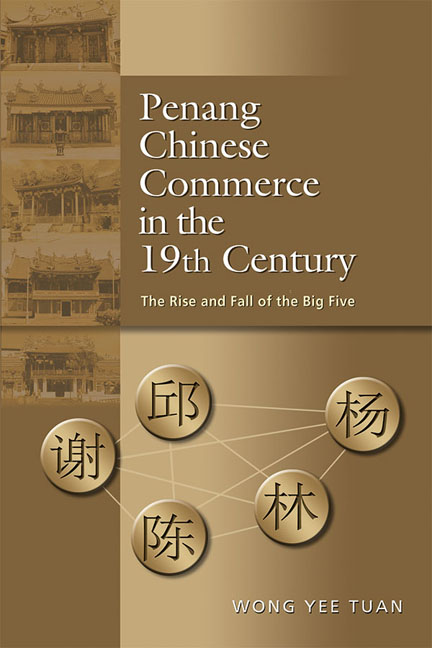Book contents
- Frontmatter
- Dedication
- Contents
- List of Tables, Diagrams and Maps
- Acknowledgements
- Glossary
- Abbreviations and Acronyms
- Notes on Spelling and Names
- Notes on Currencies
- Map
- 1 Introduction
- 2 Penang and the Big Five in Regional Context
- 3 Kith and Kin: The Big Five Familial Web
- 4 Opium Farm Rivalry
- 5 The Contest for ‘White Gold’
- 6 Western Mercantile Elite and Their Challenge to the Penang Chinese
- 7 New Regional Order and the Decline of the Big Five
- 8 Conclusion
- Appendices
- Bibliography
- Index
- About the Author
- Platesection
- Map
7 - New Regional Order and the Decline of the Big Five
Published online by Cambridge University Press: 19 May 2017
- Frontmatter
- Dedication
- Contents
- List of Tables, Diagrams and Maps
- Acknowledgements
- Glossary
- Abbreviations and Acronyms
- Notes on Spelling and Names
- Notes on Currencies
- Map
- 1 Introduction
- 2 Penang and the Big Five in Regional Context
- 3 Kith and Kin: The Big Five Familial Web
- 4 Opium Farm Rivalry
- 5 The Contest for ‘White Gold’
- 6 Western Mercantile Elite and Their Challenge to the Penang Chinese
- 7 New Regional Order and the Decline of the Big Five
- 8 Conclusion
- Appendices
- Bibliography
- Index
- About the Author
- Platesection
- Map
Summary
The Western inroads into the Big Five's shipping and trading enclaves, as discussed in the previous chapter, were not the full extent of the Western business challenge. From the 1910s onwards, Western enterprises extended their business interests towards the primary production sector, especially in tin mining and plantation agriculture. It was at this point that the full force of Western commercial powers first descended on this Penang-centred region. By organizing as public joint-stock companies, Western mercantile interests were able to gather the larger amounts of capital necessary to adopt new technologies and to attract the skilled management that would enable them to establish their supremacy in the tin and rubber industries. On top of this, the modernization and expansion of Western-style political and administrative apparatus, which increased state power, had adverse effects on revenue farms and landownership. In the face of these changes, the Big Five lost their ability to compete and began to disintegrate. This was not a natural or inevitable process, but a result of their unsuccessful attempt to cope with the problems and challenges that emerged in a dynamically changing economic and political order.
This chapter broadly outlines the economic and political changes that would ultimately disadvantage the Big Five and considers why the Big Five failed to survive as the dominant economic force in the new order. We will consider two main arenas of change in turn, beginning with tin.
The Tin Industry
Western enterprises began to gain ground in this traditionally Chinesedominated industry from the late nineteenth century. Their first inroads were in the smelting sector. From the late 1880s, Western companies began to break the practical monopoly of smelting held by the Chinese (Brown 1994, p. 77; Yip 1969, p. 105). The Straits Trading Company was most successful in this respect and by 1902, it was smelting 55 per cent of the tin exported from the Straits (Cushman 1991, p. 76). Challenged by this growing Western control over tin smelting, in August 1907 the Big Five and theirassociates established a local limited company — Eastern Smelting Company — with modern smelting facilities as part of the Khaw Group (Wong 1965, p. 229; Cushman 1991, pp. 76, 78). This enterprise was floated in England with a capital of $1.5 million.
- Type
- Chapter
- Information
- Penang Chinese Commerce in the 19th CenturyThe Rise and Fall of the Big Five, pp. 137 - 169Publisher: ISEAS–Yusof Ishak InstitutePrint publication year: 2015

